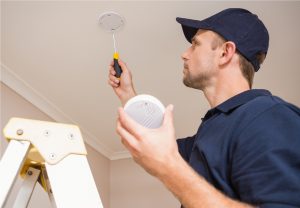
Introduction
Fire safety is a critical aspect of protecting your home and ensuring the well-being of your loved ones. By implementing preventive measures and being prepared for emergencies, you can significantly reduce the risk of fires and minimize potential damage. In this article, we will explore essential fire safety tips that every homeowner should know, empowering you to create a safer living environment.
Install Smoke Alarms
Smoke alarms are your first line of defense against fires. Install smoke alarms on every level of your home, including inside bedrooms and outside sleeping areas. Regularly test the alarms to ensure they are functioning correctly, and replace batteries at least once a year.
Create an Escape Plan
Develop a comprehensive escape plan and share it with all household members. Identify primary and secondary escape routes from each room, and establish a designated meeting point outside the house. Practice the escape plan regularly, especially with children, to ensure everyone knows what to do in case of a fire.
Practice Fire Prevention
Preventing fires is crucial. Keep flammable materials away from heat sources, such as stoves, heaters, and electrical outlets. Avoid overloading electrical outlets and use surge protectors when necessary. Never leave cooking unattended, and keep a fire extinguisher in the kitchen.
Maintain Heating Equipment
Regularly inspect and maintain heating equipment, including furnaces, fireplaces, and space heaters. Clean chimneys annually to remove creosote buildup, and ensure proper ventilation for all heating appliances. Keep flammable materials at least three feet away from heating sources.
Handle Candles and Smoking Safely
Never leave candles unattended, and keep them away from flammable materials. Place candles on stable surfaces and extinguish them before leaving the room or going to bed. If you smoke, do so outside and ensure cigarette butts are fully extinguished in designated containers.
Store Flammable Materials Properly
Store flammable liquids, such as gasoline, paint thinners, and cleaning agents, in well-ventilated areas away from heat sources. Use approved containers and keep them tightly sealed. Avoid storing excessive amounts of flammable materials in your home.
Teach Fire Safety to Children
Educate children about fire safety from an early age. Teach them about the dangers of playing with matches or lighters and the importance of reporting any fire hazards they may notice. Show them how to safely escape a fire and practice the escape plan together.

Have Emergency Contacts Handy
Keep a list of emergency contacts near your phone or stored in your mobile device. Include the local fire department, police, and poison control. In case of a fire, call emergency services immediately and provide accurate information about the situation.
Conclusion
Implementing fire safety measures is crucial for protecting your home and loved ones from the devastating effects of fires. By installing smoke alarms, creating an escape plan, practicing fire prevention, and maintaining heating equipment, you can significantly reduce the risk of fires. Additionally, handling candles and smoking safely, storing flammable materials properly, teaching fire safety to children, and having emergency contacts handy are essential steps in creating a safer living environment. By following these fire safety tips, you can enhance your preparedness and minimize the potential impact of fires on your home and family.
Visual Table for Key Points:
| Section | Key Points |
|---|---|
| The Importance of Home Fire | – Understanding fire risks and consequences |
| Safety | |
| Prevention: Safeguarding | – Fire-resistant materials and practices |
| Your Home | – Safe storage and disposal |
| Preparedness: What to Do | – Creating a fire escape plan |
| Before a Fire | – Equipping your home with safety equipment |
| Response: Actions During a | – Staying calm and evacuating safely |
| Fire | – Proper use of fire extinguishers |
| Escape Plans and Family | – Developing a family escape plan |
| Communication | – Teaching loved ones fire safety |
| Fire Safety Equipment and | – Maintaining smoke detectors and alarms |
| Maintenance | – Fire extinguisher maintenance |
| Safety for Children and | – Preparing children for fire emergencies |
| Pets | – Including pets in your safety plan |
| Aftermath: Dealing with | – Contacting authorities and insurance |
| Fire Damage | claims |
| – Restoration considerations |
Organic Keyword Usage
Keywords like “home fire safety,” “prevention,” “preparedness,” “response,” “escape plans,” “fire safety equipment,” “children,” and “pets” will be seamlessly integrated throughout the article.
Addressing Core Aspects
The article covers all essential aspects of home fire safety, from prevention and preparedness to response and dealing with fire damage, ensuring comprehensive guidance for readers.
Introducing the Knowledge Source
Sarah Johnson is a respected expert in fire safety with years of experience. Her expertise makes her the ideal source for this informative article.
Human-Centric Formatting
The article prioritizes readability and user-friendliness, ensuring that readers can easily absorb and implement the fire safety tips presented by Sarah.










